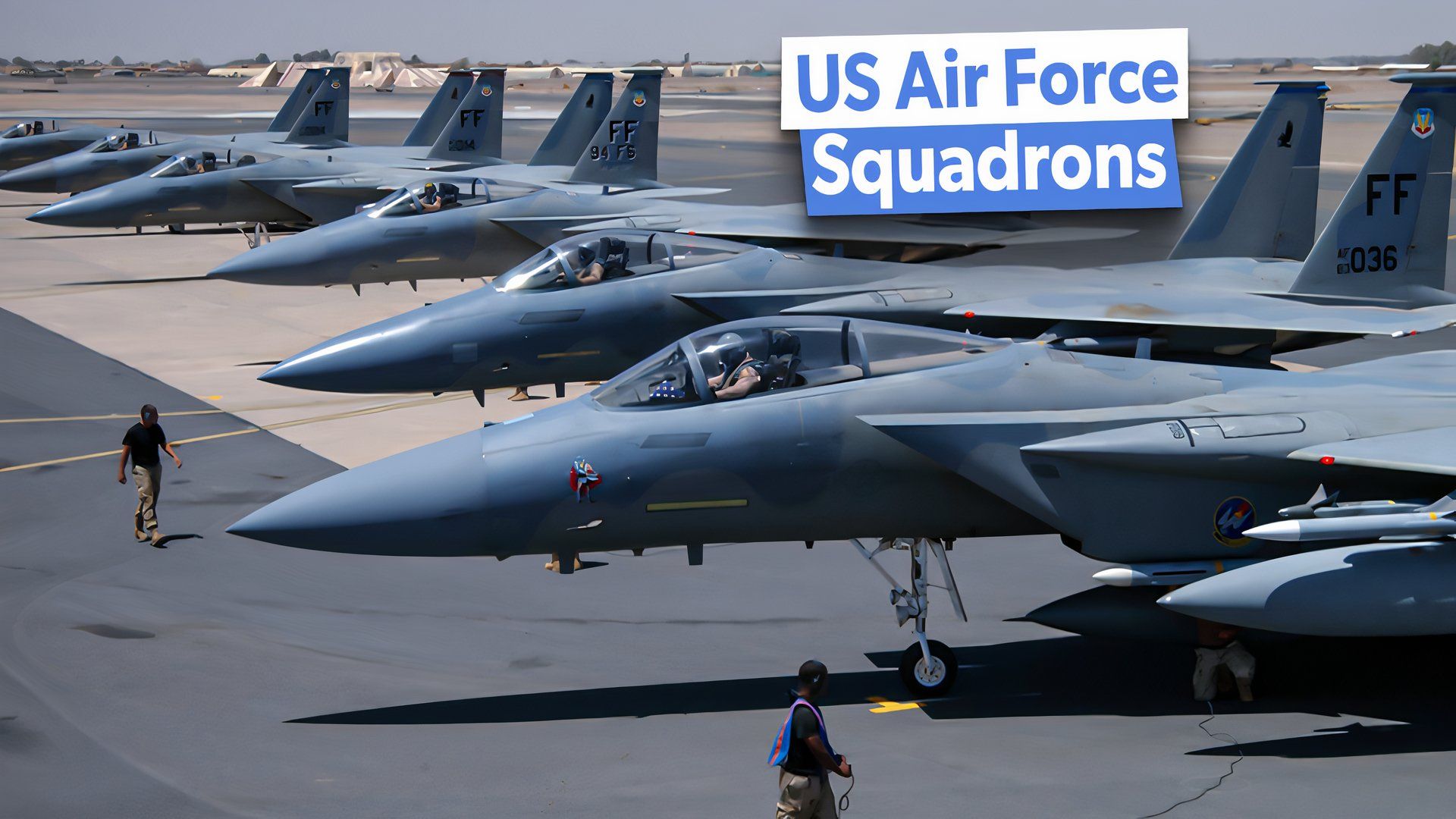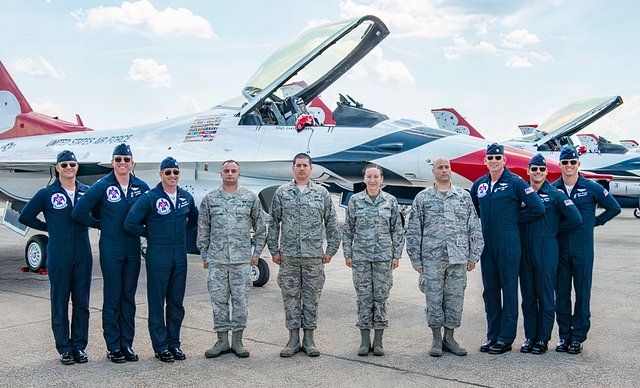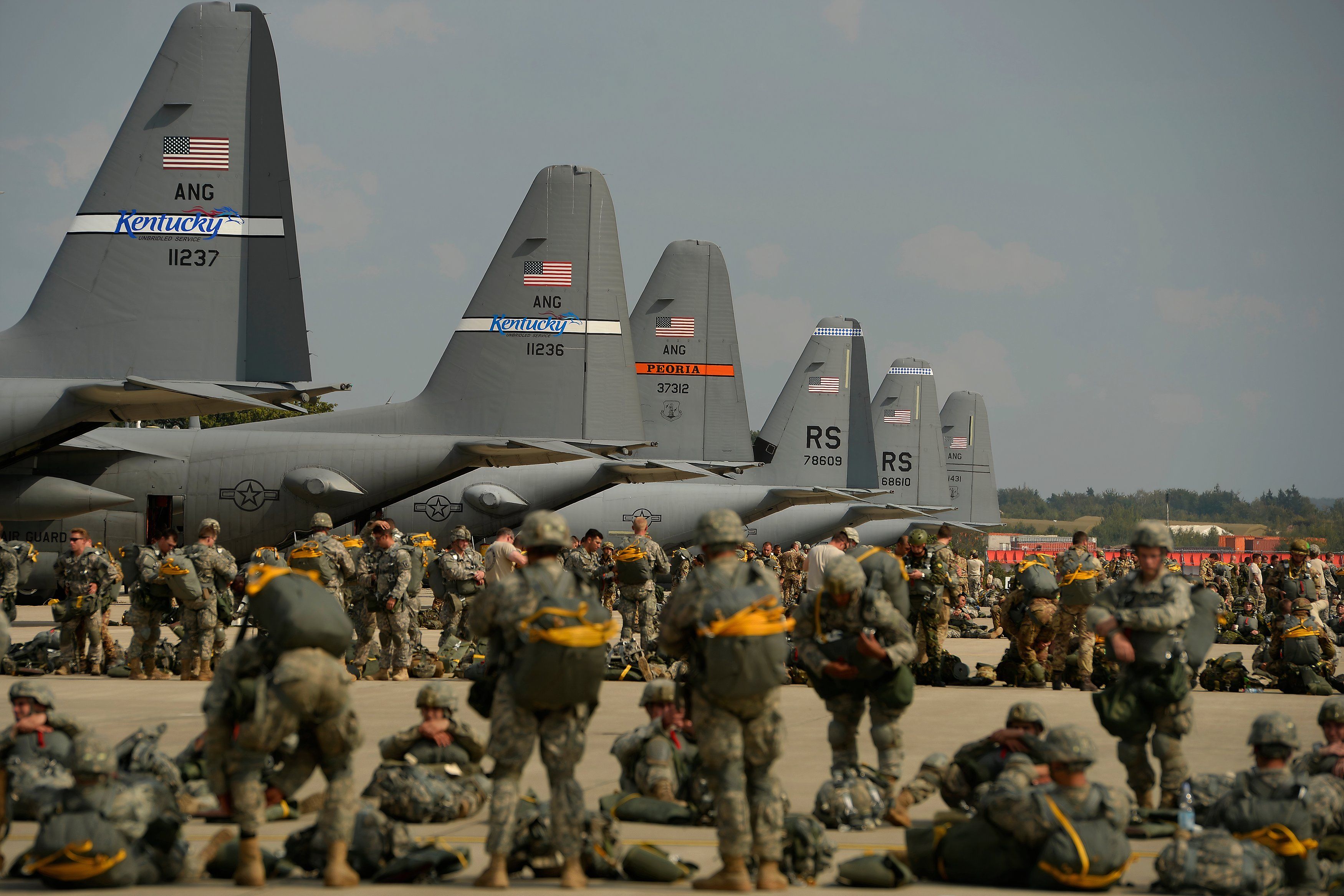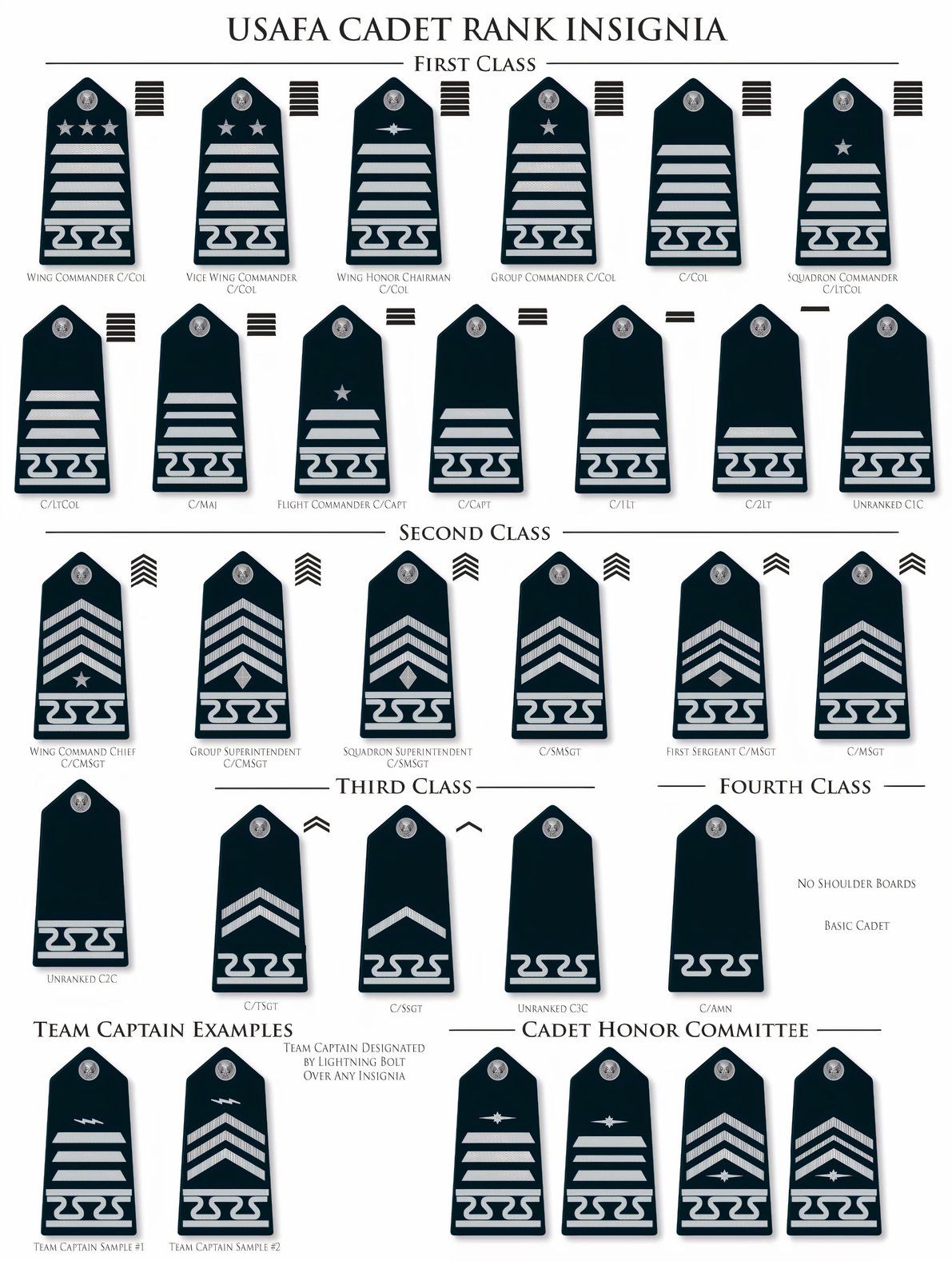A squadron in an Air Force, Navy, or Army aviation service is a group of military aircraft and their aircrews, usually of the same kind, with 12 to 24 aircraft, occasionally separated into three or four flights, depending on the aircraft type and air force.
Photo: SrA Cory W. Bush | DVIDS
Two or more squadrons constitute a group or wing. The US military also uses the term “squadron” to refer to non-flying ground troops. The squadron is the primary organizational unit. A group comprises two or more USAF squadrons, and two or more groups form a wing.
US Air Force squadrons, flying units of pilots and flight crews, can be designated as fighter squadrons, bomb squadrons, or airlift squadrons. Fighter squadrons typically sustain 18 to 24 aircraft, although bigger aircraft flying squadrons may support fewer aircraft. The US Fighter Squadrons are distributed inside and outside the US. Some of the squadrons are shown in the following table.
|
Location |
Fighter Squadrons |
|---|---|
|
Tyndall AFB |
1st, 2nd, 4th, 95th, 301st |
|
Hill AFB |
34th |
|
Minot AFB |
5th Fighter Interceptor |
|
Holloman AFB |
7th, 8th, 9th, 20th, 311th, 314th |
|
Luke AFB |
21st, 52d, 61st, 62d, 63d, 65th Aggressor, 69th, 308th, 309th, 310th, 312th |
|
Spangdahlem AB (Germany) |
22nd, 23rd |
|
NAS JRB Fort Worth |
24th |
|
Osan AB (South Korea) |
25th, 36th |
|
Langley AFB |
27th, 71st, 94th |
|
Kadena AB (Okinawa) |
44th, 67th |
|
Davis–Monthan AFB |
45th, 47th |
|
Barksdale AFB |
46th Fighter Training |
|
Seymour Johnson AFB |
307th, 333d, 334th, 335th, 336th |
|
Moody AFB |
74th, 75th, 76th, 81st |
|
Shaw AFB |
55th, 77th, 78th, 79th |
|
Kunsan AB (South Korea) |
35th, 80th |
|
Eielson AFB |
18th Fighter Interceptor, 317th Fighter Interceptor |
|
MacDill AFB |
72nd |
|
Nellis AFB |
6th, 65th, 66th Fighter Squadron |
|
Homestead AF Reserve Base |
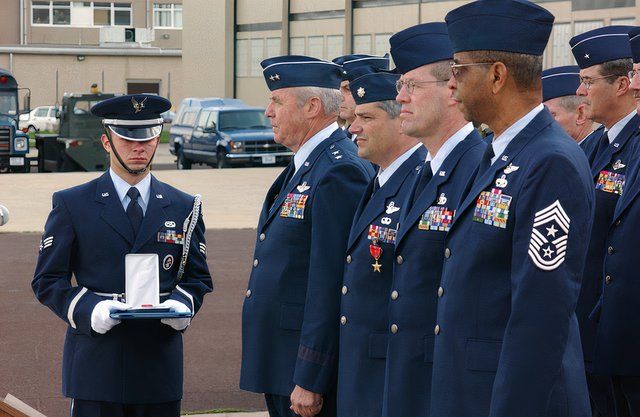 US Air Force leadership structure
US Air Force leadership structure
The US Air Force hierarchy is organized into at least ten sections.
The United States Department of the
Air Force
, led by the Secretary of the Air Force SECAF and the Headquarters Air Force (HAF), manages the Airmen’s efforts to organize, train, equip, and execute military capability while caring for individuals and their families. The Major Command MAJCOM is the next tiered organization, consisting of eleven specialized units based on functionality and geography.
“You are an unfaltering champion for our military families and the Air Force is lucky to have you.” Gen. Kenneth S. Wilsbach is the Commander, Air Combat Command, Joint Base Langley-Eustis, Virginia.
- The Secretary of the Air Force (SECAF) is a civilian who leads the Department of the Air Force, which has its own staff at the Pentagon in Washington, DC.
- Headquarters Air Force (HAF), which is Pentagon-based and led by the Chief of Staff of the Air Force (CSAF), is responsible for addressing service-wide issues alongside the SECAF and the Chief of Staff of the Air Force CSAF.
- Major Command (MAJCOM) is a tiered organization based on functionality and geography. It comprises eleven specialized forces managed by a four- or three-star General.
- Numbered Air Forces NAF consists of twenty-five tactical echelons, which provide operational leadership and supervision for assigned units. These forces are geographically assigned and primarily used during wartime. In peacetime, they consist of a limited number of headquarters staff. The NAF commander is typically a three or two-star General.
- Wings have a distinct mission with a specific scope and report to the NAF. They comprise one or more groups consisting of several squadrons, usually commanded by a colonel. The senior enlisted personnel of a wing can be known as the Command Chief, who holds the rank of command chief master sergeant.
- Groups comprise several squadrons, typically commanded by a colonel. The senior enlisted member of a group is known as the group’s senior enlisted leader (formerly group superintendent). In 2006, the USAF had 17 independent groups and nine flying establishments.
- Squadrons are considered the basic unit within the USAF and exist to provide a specific operational or support capability. Depending on the aircraft type, they usually comprise two to six flights with 35 to 700 people.
- Flight is a subdivision of a squadron, ranging from a dozen people to over a hundred aircraft. It can be a “Numbered or Named Flight,” an “alpha” flight, or a “Functional Flight.” The flight commander, also known as an “Officer-In-Charge,” is a company-grade officer (CGO) and is assisted by a senior non-commissioned officer (NCO). Flights are broken into sections and elements, which are recognized by their wings.
- Sections are internal subdivisions of a flight staffed by a non-commissioned officer (NCO) and a “Section Chief.” Some sections may be further subdivided into multiple elements, known as “work centers,” staffed by a non-commissioned officer in charge.
- A Direct Reporting Unit (DRU) is a unique agency within the US Department of the Air Force, reporting directly to the Chief of Staff or designated representative. DRUs have a specialized mission independent of major commands, operational commands, divisions, wings, groups, squadrons, or field operating agencies. They perform field activities beyond major commands’ scope.
The Air Force has around 3,300 squadrons, primarily led by Lieutenant Colonels, Majors, and Captains. The following table represents examples of squadrons.
|
Fighter |
Tanker |
Command and Control |
Aircraft Maintenance |
|
Bomber |
Missile |
Training |
Civil Engineering |
|
Mobility |
Intelligence, Surveillance, Reconnaissance |
Medical |
Mission Support |
The cadet wing organization
The cadet wing is a military organization that prepares cadets for the life of an officer by showcasing the organization of an operational Air Force wing. Cadets are responsible for running and operating the wing, learning to use a chain of command, functioning in various military formations, and organizing units to accomplish collective tasks.
The cadet wing, consisting of over 4,000 cadets, is divided into four groups of 10 squadrons each. Air officers command cadets, supervise them, provide instruction, and represent role models. Non-commissioned officers (NCOs) complement Area of Concentration (AOC) or Commissioned Officers (COs), providing an enlisted perspective and enhancing the cadets’ experience of command and organization.
Commissioned officers complete demanding missions and ensure soldiers’ welfare, morale, and professional development. They provide orders ranging from Second Lieutenant to General, protecting various ranks. A non-commissioned officer NCO does not preserve a commission and typically earns his authority through advertising.
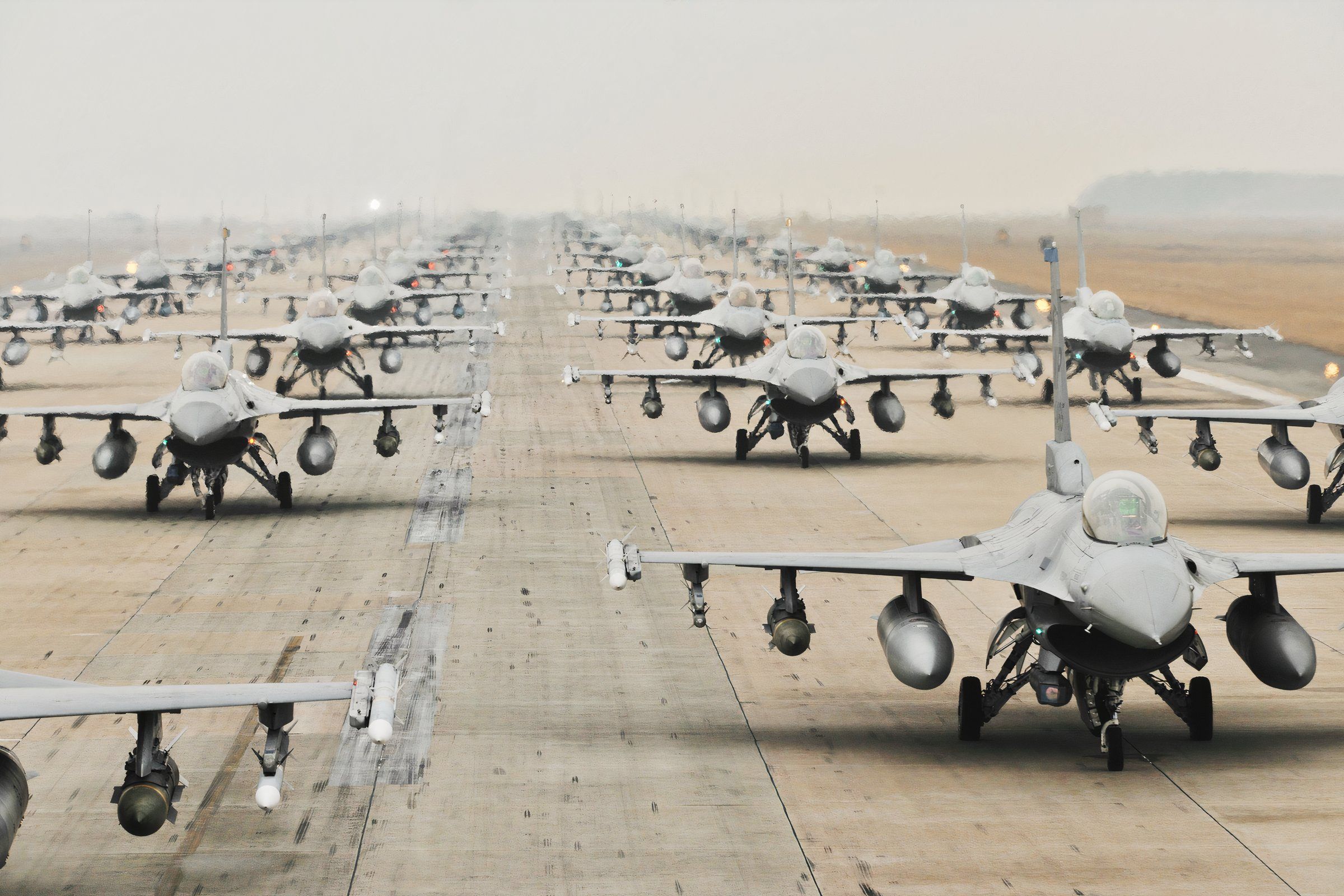 The largest aircraft inventory in history
The largest aircraft inventory in history
The USAF’s aircraft inventory consists of 5,154 active aircraft, divided into active-duty fighters and combat-coded aircraft. Separating active-duty fighters and units from the strategic reserve is crucial as it takes months to prepare elements for deployment.
|
Classification |
Inventory |
|---|---|
|
Trainers |
29.7% |
|
Fighters |
29.1% |
|
Transports |
13% |
|
Tankers |
10.7% |
|
Close-Air-Support |
6% |
|
Special Mission |
4.8% |
|
Helicopters |
4.1% |
|
Bombers |
2.5% |
Most intelligence, surveillance, target acquisition, and reconnaissance ISR aircraft are now Unmanned Aerial Vehicles UAVs. In 2024, 38
MQ-9
Block-1 aircraft will be divested, leaving 208 Reapers. Currently, the department uses approximately 11,000 UAS to support foreign contingency missions and local training activities. The smallest RQ-11B Raven and the largest RQ/MQ-4
Global Hawk
/Triton weigh more than 32,000 pounds.
Factors like squadrons’ deployment requirements and jet repair needs also affect the number of fighters the service can employ in combat. Approximately three active-duty squadrons are required to deploy two combat-capable fighter units forward.
The Air Force has reduced its active-duty fighter fleet to 571 jets, with the Air Reserve Component having 608 fighters, 458 of which are combat-coded. This means that 626 active-duty and 229 strategic reserve fighters can be deployed into combat, totaling 885 combat-coded fighters.
Concerns about alternative systems after the retirement of the F-15C are justified, as the most straightforward 186 of the planned 750 F-22A stealth fighters were added. The Air Force has leaThe F-35A is designed for air-to-floor campaigns and the operational feasibility of the F-22A.
Most US Air Force aircraft have a lifetime of 30 years. However, as time passes, fuselage bends cause stress and fatigue.
The Air Force is likewise obtaining a fourth-generation F-15EX fighter jet, which is considered less expensive to own and operate. Combat-coded aircraft and related squadrons are aircraft and units with a specific wartime duty. Therefore, those numbers do not include units and aircraft assigned to training or operational tests. The following tables represent only four aircraft types.
|
Aircraft Type |
Combat-Coded Fighters |
Average Age |
Mission-Capable Combat-Coded Fighters |
|---|---|---|---|
|
F-16C |
309 |
33 |
219 |
|
F-15E |
164 |
31 |
85 |
|
F-22A |
110 |
17 |
63 |
|
F-35A |
194 |
5 |
127 |
|
Total |
777 |
– |
494 |
There are Combat-Coded Fighter Squadrons for air national guards and air reserve squadrons. The Air National Guard operates a dual mission, requiring guardsmen to be members of both their state and the United States National Guard, as mandated by the US Constitution. The Air Force Reserve AFRES and Air National Guard ANG are Federal Reserve components of the US Air Force, with each state’s ANG under its governor’s jurisdiction. Both can be mobilized for active duty by presidential order or for state service in crises like natural disasters.
|
Aircraft Type |
Number of Squadrons Air National Guard & Air Reserve |
Number of Squadrons Air Force Active-Duty |
|---|---|---|
|
F-16 |
12 |
11 |
|
F-15E |
5 |
6 |
|
F-22 |
1 |
4 |
|
F-35 |
1 |
6 |

